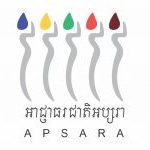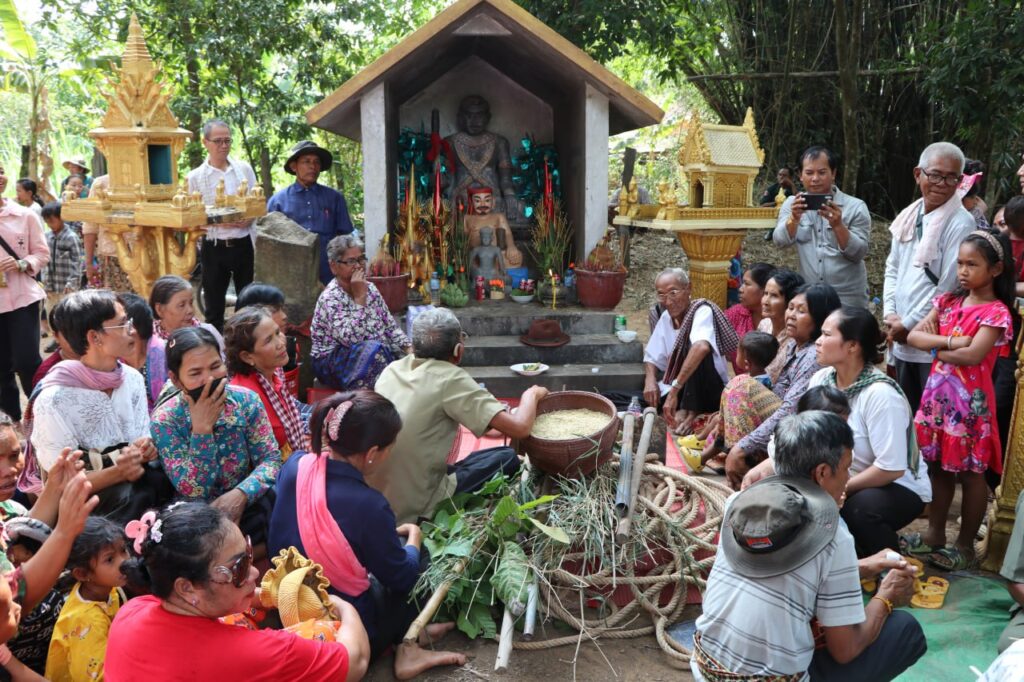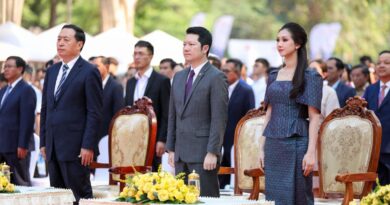កិច្ចពិធីឆ្លងឆ្នាំតាមទំនៀមទម្លាប់អ្នកស្រុកកំពង់ក្តី
ជារៀងរាល់ឆ្នាំ ក្រោយពីពិធីបុណ្យចូលឆ្នាំប្រពៃណីជាផ្លូវការបញ្ចប់ អ្នកស្រុករស់នៅជុំវិញស្ពានបុរាណនៅកំពង់ក្តី មានភូមិត្រាច ភូមិប្រាសាទ ភូមិរំលងជាដើម (ចំណុះជើងវត្តកំពង់ក្តី) តែងមូលមាត់គ្នារៀបចំកិច្ចពិធីឆ្លងឆ្នាំ ដែលជាទំនៀមបុរាណបានបន្តរៀងមកជាយូរយារណាស់មកហើយ។ ពិធីនេះក៏មានអ្នកភូមិផ្សេងទៀតនៅក្បែរៗបានសហការចូលរួមដែរ ដែលជាបរិបទវប្បធម៌តែមួយ មិនគិតពីព្រំដែនរដ្ឋបាលបច្ចុប្បន្ន។ ពេលព្រឹកអ្នកស្រុករៀបចំកិច្ចពិធីនៅក្នុងបរិវេណវត្តកំពង់ក្តីតាមទំនៀមព្រះពុទ្ធសាសនា។ ពេលរសៀលគឺមានសារសំខាន់ទាក់ទងនឹងទំនៀមអ្នកស្រុកផ្ទាល់ ដោយពុំមានវត្តមានព្រះសង្ឃទេ។ គឺចាស់ទុំព្រឹទ្ធាចារ្យក្នុងសហគមន៍ដឹកនាំកិច្ចពិធី។ កម្មវិធីដំបូង អ្នកស្រុកបានរៀបចំពិធីបន់ស្រន់សុំម្ចាស់ទឹកដី ដែលជាអ្នកតាប្រចាំសហគមន៍នៅទីមួយខាងឥសានស្ពានកំពង់ក្តី ដែលមានឈ្មោះបីផ្សេងគ្នា គឺអ្នកតាគង់ អ្នកតាសំរោងឬដំបងដែក និងអ្នកមុខរាហ៍។ គ្រឿងរណ្តាប់នៅចំពោះអ្នកតាទាំងបីនេះមានភ្ញីផ្កា បាយសី គ្រឿងក្រអូប ទៀនធូប ផ្លែឈើ បង្អែម ភេសជ្ជៈ ចំអាបមាន់ស្ងោរ ក្បាលជ្រូក បាយសម្លច្រើនមុខជាដើម ដែលមានដូចគ្នានឹងកិច្ចពិធីបួងសួងដទៃទៀតដែរ។ ប៉ុន្តែនៅទីនេះ មានអ្វីដែលប្លែកហើយពុំមាននៅទីណាក្នុងពិធីរបៀបនេះ នោះគឺខ្សែព្រ័ត្រ ស្រូវ រនាស់ ចប ជនីក អំបោស។ល។ រីឯដំណើរការកម្មវិធីវិញ មានបញ្ចូលរូបស្នងលោកតាទាំងបី ភ្ជួររាស់ កាប់គាស់ បោសសម្អាត ព្រោះស្រូវ រាំជារបាំឆ្វែលខ្ទមអ្នកតាបីជុំ និងបញ្ចប់ដោយទាញព្រ័ត្រដែលមានម្ខាងបុរស និងម្ខាងស្រ្តី។
បន្ទាប់ពីបញ្ចប់កិច្ចនៅខ្ទមអ្នកតាទាំងបីរួចហើយ អ្នកចូលរួមបានលើកគ្នាទៅកាន់ស្ពានបុរាណកំពង់ក្តីដើម្បីបន្តកិច្ចពិធីបន្ទាប់តាមទម្លាប់។ ជាដំបូងអ្នកស្រុកមកធ្វើកិច្ចពិធីបូងសួងនៅក្បាលស្ពានខាងកើតផ្នែកឦសាន ដោយមានគ្រឿងរណ្តាប់ផ្កាភ្ញី គ្រឿងក្រអូប ផ្លែឈើ ភេសជ្ជៈ បង្អែមចំអាប់ តែគ្មានស្រូវនិងគ្រឿងកសិកម្មទេ។ ពិធីបួងសួងដំណើរការអមដោយភ្លេងបុរាណផង។ ពេលចប់កិច្ចបួងសួង អាចារ្យតម្រូវឱ្យអ្នកស្រុកយកទឹកទៅលាងនាគដែលជាបង្កាន់ដៃ និងក្បាលស្ពានផង។ បន្ទាប់មក អ្នកស្រុកបានរៀបចំទាញព្រ័ត្រនៅលើដងស្ពានបុរាណផ្ទាល់បន្តទៀត ដែលលើកទីមួយ នៅខាងលិចជាក្រុមនារី ខាងកើតជាក្រុមបុរស។ លើកទី២ ខាងកើតប្តូរមកក្រុមបុរសម្តង ខាងលិចប្តូរមកក្រុមនារីវិញ។ នៅចន្លោះពេលសម្រាកពីទាញព្រ័ត្រម្តង តែងមានការចាក់ទឹក និងរាំឆ្វែលជារង្វង់ រួចបន្តទាញបន្តទៀត រហូតដល់ចំនួនកំណត់របស់លោកអាចារ្យ និងចុងក្រោយអ្នកភូមិនាំគ្នាទៅទាញព្រ័ត្រផ្តាច់នៅសាលាឆទានជាកិច្ចបញ្ចប់។ សូមបញ្ជាក់ថា ពិធីទាញព្រ័ត្រនេះ បានរៀបចំមិនដែលអាក់ខានទេ ទោះនៅក្នុងសម័យកូវិតក៏ដោយ តែគ្រាន់តែបន្ថយចំនួនមនុស្សចូលរួម និងអនុវត្តតាមវិធានការណ៍សុខាភិបាល។
ឆ្លើយតបនឹងសំណួរមូលហេតុនៃការរៀបចំកិច្ចពិធីដ៏មានសារសំខាន់នេះ លោក អ៊ឹម សុខរិទ្ធី បុរាណវិទូនិងជាប្រធាននាយកដ្ឋានស្រាវជ្រាវ បណ្តុះបណ្តាលនិងផ្សព្វផ្សាយ បានផ្តល់ការយល់ឃើញរបស់លោកមកថា «នេះមិនមែនពិធីបុណ្សទាក់ទងនឹងព្រះពុទ្ធសាសនាទេ។ ជាប្រពៃណី ទំនៀមទម្លាប់របស់សហគមន៍មនុស្សជុំវិញស្ពានបុរាណនៅកំពង់ក្តីនេះផ្ទាល់។ មិនមែនជាចៃដន្យ ដែលពិធីនេះរៀបចំទ្បើងនៅថ្ងៃ១កើត ខែពិសាខ ពោលគឺបានឆ្លងផុតចេត្រ ផុតឆ្នាំចាស់ បានចូលមកឆ្នាំថ្មី ឬនិយាយបានម៉្យាងទៀតថា វេលាដែលចេញផុតពីវដ្តកសិកម្មចាស់ ចូលមកវដ្តកសិក្មថ្មី គឺរដូវវស្សាបានមកដល់ហើយ។ អ្នកស្រុកបានរៀបចំជាកិច្ចពិធីតាមទំនៀមទម្លាប់របស់ខ្លួន ទាញព្រ័ត្រឆ្លងឆ្នាំ ដោយផ្តាច់ព្រ័ត្រជាឆ្នាំចាស់ ដើម្បីឆ្លងមកឆ្នាំថ្មី។ ចាក់ទឹកលើកនាគ ចាក់ទឹកលើមនុស្សចូលរួមជាកិច្ចថានឹងបានភ្លៀងខែវស្សា នាគបានទម្លាក់ទឹកមកពីលើមេឃ។ បោសសម្អាតលានស្រែ ភ្ជួរាស់ កាប់គាស់ សាបព្រោះស្រូវ គឹការងារកសិកម្មរបស់សហគមន៍បានមកដល់ ដោយមានម្ចាស់ទឹកដី អ្នកតាទាំងបីឱ្យពរជ័យ បានភ្លៀងច្រើន គ្មានរន្ទះ ទទួលបានខ្យល់ស្លូត ជៀសផុតរោគភ័យ កសិផលបានច្រើន សហគមន៍ចម្រុងចម្រើន»៕
អត្ថបទ: យី សុថា
រូបភាព: យី សុថា, ជា វណ្ណៈ, ស៊ី សុខុន
New Year Tradition at Kampong Kdei
Every year, after the official New Year celebrations, the locals living around the ancient bridge, Kampong Kdei, in Trach village, Prasat village, Romlong village, etc. always come together to organize the New Year ceremony, which is an ancient tradition. The ceremony is also attended by other nearby villagers, a unique cultural context regardless of the current administrative boundaries. In the morning, the locals hold a ceremony at the Kampong Kdei pagoda according to Buddhist tradition. The afternoon is important in relation to the local tradition without the presence of monks. Elders in the community lead the ceremony. In the first program, the locals hold a praying ceremony for the local spirits with three different names: Neak Ta Kong, Neak Ta Samrong or Dambang Dek, and Neak Mukh Rea. There are offerings such as bay sei, flowers, incense, candles, fruits, desserts, soft drinks, chicken, pork head, rice, various kinds of soup, etc., which are the same as other praying ceremonies. But here there is something different and nowhere in this kind of ceremony, such as pulling rope, rice, rakes, shovels, brooms, etc. As for the process of the program, it includes the statues of the three Nak Ta above, plowing, harrowing, digging, clearing, spreading the rice crops, dancing around the hut of Nak Ta, and ends with a tug of war with one side for men and one for women.
After completing the ceremony at the hut of Neak Ta, the participants marched to the ancient bridge of Kampong Kdei to continue the next ceremony as usual. First, the locals come to the eastern end of the bridge, with flowers, spices, fruits, drinks, sweets, but no rice and agricultural products. The praying ceremony is accompanied by classical music. At the end of this praying ceremony, the abbot is required to take water to wash the head of Naga, which is the balustrades of the bridge. The locals then proceed to tug of war game on the ancient bridge, the first time in the west as a group of women in the east as a group of men. The second time, the east changed to the men’s group, once the west changed to the women’s group. Between breaks from pulling, there is always pouring water and dancing in a circle, and then continue pulling until the abbot stops this pulling. It should be noted that the ceremony is held regularly, even in the Covid period, but only to reduce the number of participants and implement health measures.
Answering the question of the reason for organizing this important ceremony, Mr. Im Sokrithy, an archaeologist and director of the Department of Research, Training and Communication, giving his opinion: “This is not a Buddhist ceremony. It is a tradition of the community around the ancient bridge, Kampong Kdei itself. It is no coincidence that this ceremony is held on the first day of the month of Pisak, that is, after passing the old year, entering the new year, or in other words, the time from the old agricultural cycle to the new agricultural cycle season. The rain has arrived. The locals have organized a traditional ceremony to end the old year and welcome the New Year. Pour water on the Naga balustrade, pour water on the people involved in the ceremony to get rain. It is believed that the Naga drops water from the sky. “Clearing the fields, plowing, sowing and sowing rice, the agricultural work of the community has arrived, with the three Nak Ta blessing the rain, no lightning, getting gentle breeze, avoiding many agricultural diseases, and prospering the community.”
Article: Yi Sotha
Photos: Yi Sotha, Chea Vannak, Si Sokhon





